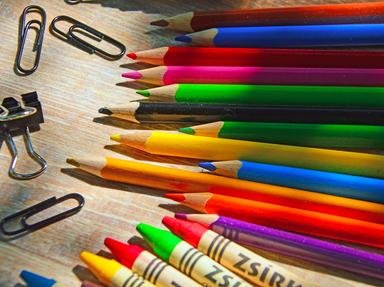Quiz Answer Key and Fun Facts
1. The ancient Greeks, Egyptians, Chinese and probably other cultures used writing implements of some sort but it was the Romans that gave us the modern word for pencil. They used a fine brush called a pencillus but do you know what this Latin word means?
2. The first recorded use of graphite as a writing material was in the 16th century when a large deposit of very pure graphite, which could be mined, was found in England. Where was this deposit uncovered?
3. In the 18th century people began to try to use less pure forms of graphite and it was combined with other substances. The graphite was powdered and then mixed with a binder before being formed into a usable stick. What was the binder that became the basis for modern pencils?
4. In 1824 a small factory making pencils was set up and run (together with a member of their family) by a person who became a famous author. Can you name this author?
5. Until about 1870, nearly all pencils were square in shape and made by hand. However, around that time, Joseph Dixon invented a machine that could mass-produce them. How many pencils could he produce per minute?
6. A plain pencil lead would make a mess of your hands and so, from a very early stage, it was encased in wood to make the lead easier to handle. Which is the most popular wood used today for this purpose?
7. Today, pencils are very common and we use them without a second thought, throwing them away if they break. If we kept one and used it right down to the very last nub of graphite to draw a continuous line, how long do you think that line would be?
8. Pencils are graded according to the hardness or softness of the lead and the commonest system for this uses a combination of numbers and letters. In the US a system based solely on numbers is sometimes used. Which is the most popular grade of pencil purchased today?
9. Pencils are no use if they aren't sharp. The first portable pencil sharpener was patented in 1897 in America. Who invented it?
10. There is a museum dedicated to the pencil near to the place where the first pure deposit was discovered in the 1560s. Where is this museum?
Source: Author
Mink
This quiz was reviewed by FunTrivia editor
gtho4 before going online.
Any errors found in FunTrivia content are routinely corrected through our feedback system.

